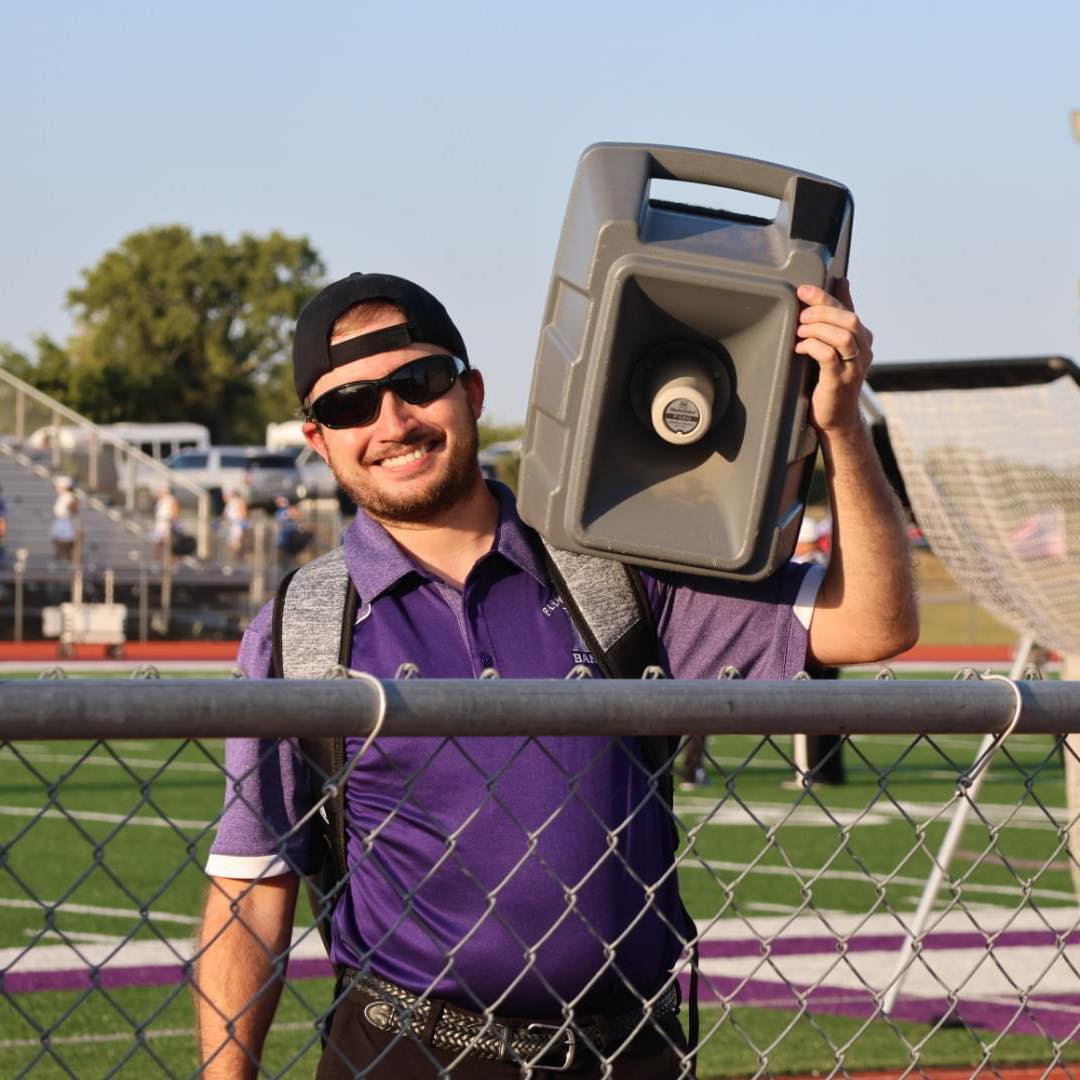In an ideal world, we’d generally recommend a decent quality audio interface/preamp and an XLR microphone over a USB mic – but we don’t live in an ideal world.
Because some people just need to plug a mic straight into their PC or Mac without having to worry about stuff like phantom power and that’s where USB microphones are just what the doctor ordered, but what is the best USB microphone for recording music?
As you’ll see, every mic in this list will do a decent job for you as they’ve all been selected with ‘musicality’ in mind. Selecting the best USB microphone however wasn’t easy – but we’ve made our choice: the Samson G-Track Pro.
USB mics contains all the elements of a conventional microphone but also include a preamp and analogue to digital (A/D) converter so you don’t need an audio interface or mixer. Just plug in and go.
But not all USB microphones are created equally. A big problem with the bargain bucket variants is that there’s a noticeable delay (latency) between the sound going into the microphone (perhaps playing a guitar or singing a vocal) and the sound you hear coming out on your headphones.
That’s because the analogue to digital converters are contained within the microphone itself and the conversion process takes a little time – resulting in a horrible delay.vocals
Decent quality USB mics get around this wholly undesirable situation by featuring a headphone jack in the mic itself that allows real-time monitoring.
You won’t be surprised to learn that every mic in this review has this feature. For recording music, it’s an absolute no-brainer and anyone caught using a mic without this essential addition should be court marshalled!
Rest assured, you can absolutely make high quality recordings with just a single USB mic. You just need to know which one to get and that’s where we come in. Read on to find our recommendation(s) for the best USB microphone.
Criteria: What we considered in this review
A microphone generally lives and dies by one thing – what it sounds like? But it certainly shouldn’t be the only consideration. In this round up of the best USB microphones out there, we also considered stuff like additional features and how useful they are; build quality; versatility, and what systems they’ll work on. And then of course there’s the ever important price factor.
1. Best Overall: Samson G-Track Pro
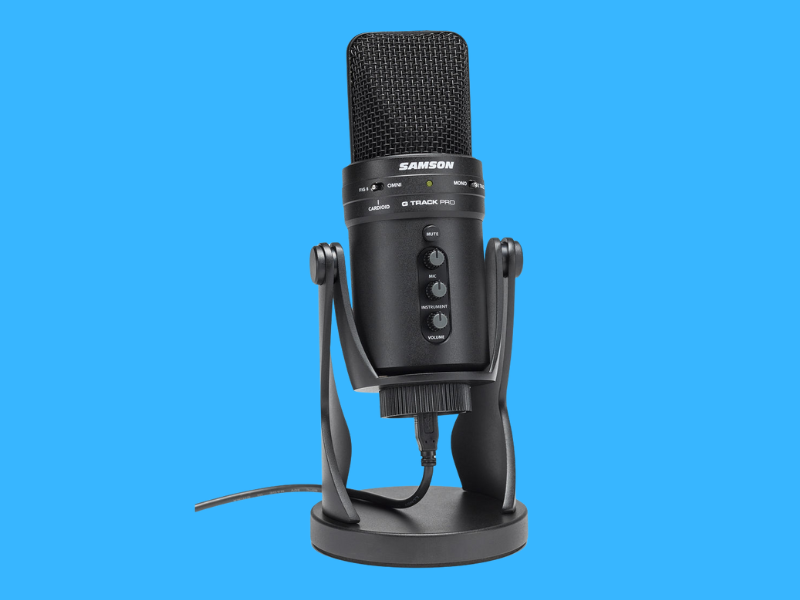
Suitable for use with Mac or PC, the Samson G-Track Pro is the winner of our best USB microphone award.
Sound wise its 96kHz 24-bit recording quality means it holds its own against any microphone in this review – but it’s the built-in additional goodies that really makes this mic stand out.
Like three selectable polar patterns: cardioid, bi-directional, and omnidirectional – but the real killer feature is the fact that this is a mic, audio interface and mixer all in one. It features a 1/4” jack input for guitars and basses for example, which can be used simultaneously while you’re singing into the mic.
Even better is the inclusion of a ‘Mono /2-Track’ switch. In Mono, you can record the mic and instrument to a single track on your DAW, while the ‘2 track’ option sends the mic and instrument signals (voice and guitar for example) to two separate tracks.
This means you can play and sing simultaneously but record them on separate tracks for individual processing. It’s also a basic mixer with independent controls for the mic and Instrument volume controls to optimize your mix.
We don’t need to tell you that a headphone amplifier offers zero latency monitoring.
The G Track Pro comes with a really hefty non-slip desktop stand but, depending on application, you may need to buy a shockmount. Oh and a popshield.
The Pros
- Because it’s a mic, audio interface and mixer in one, this is a great choice for anyone on a budget that wants to get into recording
- Plug & Play
- Multi-polar pattern option
- Versatile: good on anything: vocals, piano, acoustic and electric guitars
- Well rounded sound
- Great price
The Cons
- The controls are a little flimsy – particularly the mute button
- Minor, but at 50Hz – 20kHz the frequency response narrower than some other mics
- A little noisy in Omni mode
- You may need to buy a shockmount
In a Nutshell
The ability to recording two tracks simultaneously with basic mixing functionality swung the deal for us. On a budget, this represents excellent value for money giving you everything you need to start recording. A worthy winner of our best USB microphone gong.
2. Recommended: Blue Yeti Pro
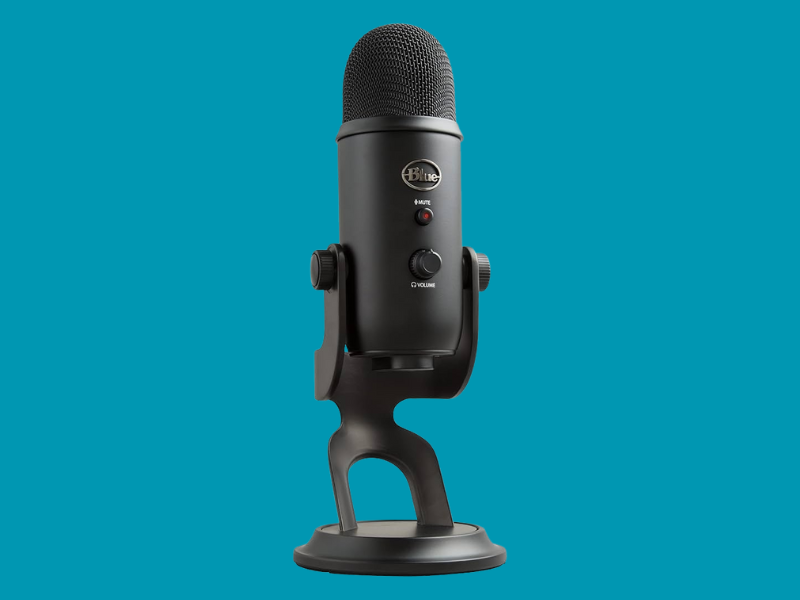
The Blue Yeti Pro is a Windows/iOS 20Hz – 20KHz four-polar patterned USB condenser and definitely not to be confused with the ‘standard’ Blue Yeti. This is the pro audio version and is far better in a music studio environment. The price reflects this.
A nice feature is its dual XLR/USB functionality which offers a degree of future proofing. Connect direct to your PC or laptop via USB, or to an audio interface or mixer through XLR.
The analogue to digital converter offers 24-bit/192kHz resolution – more than 4x CD quality, making it one of the highest quality USB microphone available – and the highest in this review. Not surprisingly, recordings are highly detailed.
Yep we did say four polar patterns: cardioid; omnidirectional; stereo and bidirectional – functionality not available on any other USB mic. With three custom 14mm condenser capsules, this thing is a veritable Swiss Army Knife and like having four microphones in one.
On the mic itself there are some additional controls: analog gain, headphone volume and a mute button. A headphone jack provides zero latency monitoring.
The Blue Yeti Pro comes with a sturdy desktop stand but also had a traditional 5/8” mic stand connection for mounting on a stand – or the Radius II, its custom designed shockmount which will set you back an additional $50.
We recommend this option. The desktop stand is insanely sensitive to knocks. We’ll assume you don’t want a herd of wildebeest on your recordings.
The Pros
- Highest recording resolution
- Warm, smooth and bright sounding on vocals, electric and acoustic guitar
- Four selectable polar patterns (stereo is really impressive on acoustic guitar)
- USB/XLR options mean built-in future-proofing
The Cons
- Expensive
- 120dB maximum SPL so not for ultra-loud environments
- Surprisingly some users have reported excessive hissing in XLR mode
- Not plug and play. You need a downloadable driver for Windows
- You’ll need a shockmount. The stand provided is a vibration magnet
In a Nutshell
With its dual USB/XLR modes of operation, 24-bit/192kHz recording quality and four polar patterns, this is a highly impressive mic with wads of future proofing capability thrown in. It is expensive though and getting mighty close to audio interface/XLR mic territory.
3. Best Value for Money: Audio Technica AT2020 USB+
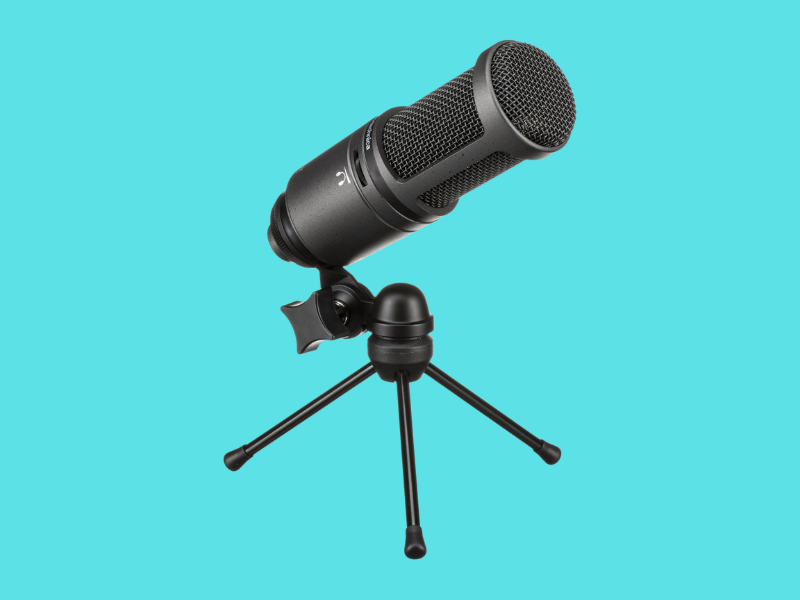
Not to be confused with the previous incarnation of this microphone (the AT2020 USB), this latest variant – the USB+ – features some welcome enhancements, namely an improved frequency response of 20Hz – 20kHz and a headphone jack for zero latency monitoring.
With its all-metal construction and weighing in at a substantial 386g, the AT2020 USB+ is a PC and Mac compatible side address, medium diaphragm cardioid microphone that would look at home in any studio.
If you’re obsessed with sound resolution stats, the AT2020 USB+, with its 44.1kHz/48kHz 16-bit resolution is one of the lowest performers in this list – but worry ye not because it still sounded pretty decent to us. Sometimes you have to look past the figures and just listen.
The frequency curve is relatively flat apart from a slight boost in the 5-12kHz range and we found the mic to be very warm sounding on electric and acoustic guitars and vocals.
There are two adjustable serrated dials on the mic: one is a headphone volume control; the other is a mix control that blends microphone and pre-recorded audio – offering zero latency monitoring of course. What more do you need?
You do get a desktop mic stand supplied with the AT2020 USB+ but it’s a tad hit and miss. Get the center of gravity right and it works, but get it wrong and the thing will topple over. Mounting on a mic stand is definitely recommended and for serious vibration-free use, a shockmount would be a wise purchase.
The Pros
- Versatile and rich sounding across the spectrum
- Solidly and professionally built
- Low noise
- Well priced
The Cons
- Don’t trust that desktop stand
- Lower sound resolution than some mics in this list
In a Nutshell
The Audio Technica AT2020 USB+ is just a decent quality no nonsense microphone that will do a good job without breaking the bank.
4. Apogee Mic Plus
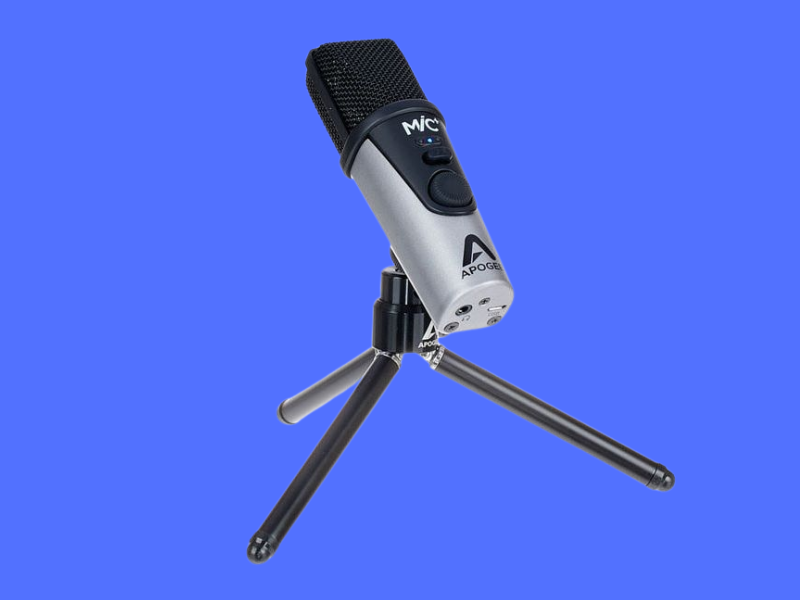
Apogee’s esteemed MiC 96K microphone has been around for a while now but now the company has taken things to another level with the Apogee Mic Plus.
This cardioid condenser mic is distinctly multi-platform and designed for Macs, PC, iPhone and iPad. Set-up is simplicity itself – just connect to your computer or iOS device, select the Mic Plus as your audio interface and away you go.
In essence this is a microphone, preamp and analog to digital converter in one. Apogee calls this PureDIGITAL – which is a fancy way of saying how the mic processes audio, combining all three elements in a really compact package. This thing weighs less than 0.5lb.
24-bit/96kHz resolution offers top notch sound quality and a welcome addition ominously missing from the MiC 96K is a headphone jack for zero latency monitoring. A Blend control takes care of what you hear in your cans – mic only, recorded output only or a blend of the two.
The Gain control on the Mic Plus is also a nice touch and provides 46dB of preamp gain for low noise operation. The mic sounds balanced and smooth across the frequency spectrum on vocals, acoustic and electric guitars and even drums.
This is a great example of how USB mics are really starting to rival entry-level XLR microphones – but we can’t ignore the fact that this will set you back a fair few beer vouchers.
The Pros
- Excellent sound quality
- Plug and Play
- Multi-platform operation – including iOS
The Cons
- The ‘infinite’ gain knob – it just keeps on turning. Having no start and end point can be confusing. The only visual indicators are LED lights – and they’re not very precise
- Expensive
In a Nutshell
A really good example of a high quality USB microphone. The Mic Plus is a definite improvement over the MiC 96K and the zero latency capability is a no brainer. It’s versatile, small and light and it’ll work just fine on your iOS device if that floats your boat.
5. Rode NT-USB

It’s hard to find a microphone comparison anywhere that doesn’t feature a Rode product and this ‘Best USB microphone’ review isn’t going to break with convention anytime soon.
The NT-USB package contains everything you need to start recording: the mic (obviously), a pop shield, a tripod desk stand, ring mount, storage pouch and USB cable. Rode’s two year extended warranty is also available if you buy from an authorised dealer.
This is a high quality 20Hz – 20kHz cardioid condenser microphone with the convenience of USB connectivity. Like all mics in this review, a 3.5mm headphone jack offers zero latency monitoring – but the NT-USB also includes a direct mix control to get the required blend between mic input and source output in your cans.
Although fully compatible with all mainstream recording applications on both Windows and Mac OS, Garageband users can also celebrate because cunningly you can also use the NT-USB with your iPad. You’ll need a suitable USB connection adaptor, such as the Apple Camera Connection Kit.
With a bass roll-off below 200Hz and frequency boost at 2 – 5kHz, the NT-USB isn’t exactly flat but in use the mic turns in a creditable natural sounding performance requiring very little post eq if you experiment with settings and mic placement.
It’s very sensitive though so watch out for high SPLs. In our opinion, the Rode NT-USB would be ideal for singer/guitarists but with a maximum SPL rating of 110dB, it may not be the tool of choice for ear splitting band recordings.
The Pros
- An all-inclusive package
- A nice warm sounding mic at a decent price
- iPad friendly
- Direct mix control is useful for monitoring
- Really well made
The Cons
- Only 48kHz/16-bit resolution which although exceeds CD quality, is one of the lowest in this test
- It’s very sensitive so noisy recording environments are a no, no
- May be unsuitable for high SPL environments like full band recordings
- No gain control on the mic which would be a useful addition
In a Nutshell
The Rode NT-USB is a quality microphone at a decent price however this is a 16-bit microphone which is the minimum we’d go to for recording music. There’s little between this and the Audio Technica AT2020 USB+ but we prefer the less colored sound of the latter.
The Bottom Line
It’s a bit cliched but really all of these USB microphones are high quality and we selected them all carefully because there is a lot of garbage out there. The sheer versatility of the Samson G-Track Pro however won us over.


